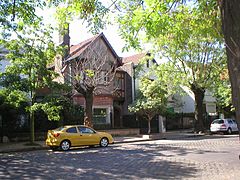Belgrano (Buenos Aires)
Belgrano is a district in the north of the Argentine capital Buenos Aires . It is 6.8 km² and has about 130,000 inhabitants (as of 2010).
location
To the south-east of it lies Palermo , to the north-west of Núñez . Coghlan , Villa Urquiza , Villa Ortúzar and Colegiales are located southwest of the district.
history
Belgrano was named after Manuel Belgrano , a politician and military man who also designed the Argentine flag. In 1820, when Belgrano died, a law was passed that the next town founded would be named after him. This happened in 1855. The settlement grew very quickly and was also the capital of Argentina for a few weeks. The law according to which Buenos Aires should be the future capital was also passed by chance in Belgrano. In 1887 Belgrano was incorporated into Buenos Aires, together with Flores .
Breakdown
Belgrano is an upper-middle-class residential neighborhood roughly divided into Belgrano R, Belgrano C, Central Belgrano, and Lower Belgrano (Bajo Belgrano). The heart is the Avenida Cabildo , which runs from the northwest to the southeast. Line D of the subway (Subte) follows its course. The street gets crowded on weekends, when porteños from other districts come here to shop too .
To the west of Avenida Crámer is the Belgrano R residential area with its quiet, tree-lined streets. The houses here are mostly detached single-family houses, often with a swimming pool in the garden, that are inhabited by wealthy Argentines and foreign business people.
In Belgrano C you can also find the Barrio Chino (Chinatown) of Buenos Aires. There are many restaurants and grocery stores here that cater to the needs of residents of Asian descent.
The district also includes the Universidad de Belgrano , a private college. You can also often see people walking dogs for work. Although the law only allows a maximum of 10 dogs per exporter, some take up to 20 for walks, which significantly contributes to the pollution of the sidewalks.
Attractions
The Barrancas de Belgrano park was designed by the architect Carlos Thays , who also created other public spaces in the city.
Handicraft exhibitions are held regularly in Manuel Belgrano Square . Here you can also find a small bust of the namesake.
The Inmaculada Concepción church , also called "La Redonda" because of its (round) shape, is popular for weddings.
Technical School No. 28: "French Republic" was the first school in Argentina to specialize in electronics.
There are also two museums: the Larreta Museum and the Sarmiento Museum . The former shows Spanish art and is named after the Spanish writer Enrique Larreta who originally lived in the house. The museum also has an Andalusian garden. The Sarmiento Museum displays objects from the property of the former presidents Domingo Faustino Sarmiento and Nicolás Avellaneda . The building is the former town hall of Belgrano, where the decision was made that Buenos Aires should be the capital in the future.
In the Belgrano area there is also the El Monumental football stadium , which is home to the River Plate football club and where the Argentine national football team also plays.
Germans in Belgrano
In the middle of the last century, many German emigrants lived in Belgrano. The Pestalozzi School in Belgrano is bilingual and focuses on the German language. Until the early 1990s, there was also the Goethe School in Belgrano with a similar focus.
The term Belgrano derives from Belgrano and describes a mixture of the German language with Spanish terms, some of which are still spoken today by descendants of German immigrants.
Personalities
- Aleksandar Zankow (1879–1959), Bulgarian National Socialist politician and Prime Minister
- Walther Darré (1895-1953), agricultural politicians, Reich Farm Leader and Reich Minister for Food and Agriculture
Web links
Individual evidence
Coordinates: 34 ° 33 ′ 45 ″ S , 58 ° 27 ′ 30 ″ W.



